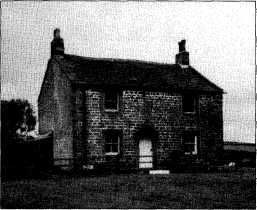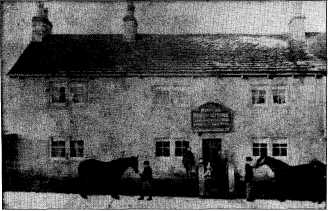| JOURNAL 1995 |
| North Craven Heritage Trust |
A cousin of mine believes that Wolfendens could be divided into two groups, those who were enterprising and energetic and who did well as a consequence, and those who were lazy and "made nowt out". James was one of the go-ahead ones.
He was born at Sedgwicks, a small farm just south of Tosside, in 1784, the eldest son of Robert and Elizabeth (Betty) Wolfenden. Robert was of yeoman stock, but his father, James Wolfenden Senior of Farr Gill, now Higher Ghylls, died when Robert was only seven. Two of his brothers inherited land or property, whilst he and the other younger boys each received £50 when they came of age. With this, and perhaps with help from his father-in-law, John Heaton of Chapel House, Stocks-in-Bowland, he was able to rent and stock a farm.
There were two farms at Studfordgill at that time and Robert moved there in 1786. Judging from the amounts which Robert and his neighbour paid in Land Tax, the Wolfenden farm was the smaller one, probably no more than 40 acres, which was about average for farms in Tosside. Robert must have relied on his son James for help on the farm because although he and Betty had nine daughters, they only had two other sons and one of these had died in infancy. So when James was married at Giggles wick Church in November 1810, he brought his bride to Studfordgill. She was Isabella, daughter of William and Margaret Hall of Hollin Hall, Rathmell. Poor Isabella's married life was short. She had three boys in quick succession and then, in August 1815, she died following the birth of her little daughter. The baby was christened Isabella at Tosside Church the day after her mother was buried at Slaidburn.
A year later James, who was to live at Studfordgill until his death in 1858, took over the tenancy from his father. This is one of the mysteries, as yet unsolved, for Robert was only 59 and was to live another 23 years. Perhaps he had some illness that was disabling but not fatal, at all events, it was James who was the tenant after 1816. It could be wondered how he coped with four small children on his own, but his parents were still living at Studfordgill and his sister, Alice, with her husband, Henry Robinson, a shoemaker, and their growing family. They all squeezed into one farmhouse!
James remained a widower for seven years but there were several changes in 1822. His mother died in January and was buried at Slaidburn, and during the year his father went to live with his daughter Elizabeth, who had married Richard Robinson of Black House. Alice's husband took Dickenson Heights, a small farm nearby, and they and their family moved out. Finally, James married again.
He was now 38 and he chose the 21 year old daughter of a Haworth farmer as his second wife. It is not known how they met. She was Betty Hartley, and they were married at Haworth Church on 4 November, 1822 by the Rev. Patrick Bronte, father of the famous sisters.
So Betty came to Studfordgill, bringing her daughter, Nanny Hartley, whose name and date of birth, 13 December 1819, were entered in the Family Bible following Robert 1811, William 1812, John 1813 and Isabella 1815. It wasn't long before more names had to be added -James, born in 1823 was followed at intervals of approximately two years by Joseph, Thomas, Henry, George, Pickles, Richard, Elizabeth and Mary who was just 4 days old when the first full census was taken in June, 1841. She was, as you will have noticed, thirty years younger than her eldest brother. So whereas his parents had had nine daughters and three sons, James had ten sons and three daughters by his two wives. Three of his brothers and sisters had died young, but every one of his own thirteen children, and Nanny Hartley, his stepdaughter, were reared successfully, quite remarkable in those days of high infant mortality.
Meanwhile, the farm was doing well and James had been able to expand. In the 1830's the larger of the two farms at Studfordgill fell vacant and he took it over, so that at the time of the census of 1841 the Wolfenden family was the only one farming at Studfordgill. James must have taken in more land, too, the Tithe Returns of 1846 show him farming 150 acres and in the 1850's he continued to prosper, so that at the time of his death he was farming well over 200 acres. Although some of this was rough grazing, Studfordgill was a big farm compared with most of those in Tosside at the time, yet there was no way that it could support all those sons.
By this time, of course, his first family were making their own way. Robert and John were farm labourers and never had their own farms but William, my great-grandfather, was one of the enterprising Wolfendens, In 1841, when he was still under 30, he was farming Ormsgill Green, a big sheep farm above Airton, and employing four men, one of them his elder brother, Robert. His sister, Isabella, kept house for him until he married Ann Harrison, daughter of John and Margaret Harrison of Ragged Hall, at Gisburn Church in 1842.
Two of James's second family were settled on farms by 1850. There had been a double wedding at Giggleswick Church on 3 March 1849 when James married Alice Charnley of Rathmell and his younger brother, Henry, married Ellen Proctor of Halton Gill. These two had contrasting careers. James farmed at Slaidburn all his life, first at Phynis and then at Woodhouse Gate, whereas Henry was always on the move. He and Ellen had twelve children and records of their births, baptisms and marriages show the family on farms at Hellifield, Rathmell, Eldroth, Colne, Kildwick and Keighley with a short spell at an inn at Stanbury and a longer time in Waterloo, Liverpool, where Henry was a cowkeeper. Finally, they returned to Keighley where Henry built 8 houses and lived and died in one of them. Another son, George, lived at Studfordgill for two years after his marriage to Alice Dawson of Settle. He was there when his father died, but when his brother Thomas came back to the farm, George went to farm at Haughfield, near Coniston Cold.
During his last years James must have been saddened when five of his children, four sons and a daughter, decided to emigrate. There is some evidence that he had tried to provide work for them all at Studfordgill. In 1851 four sons were at home. James was then 68 and perhaps unable to do a great deal, so two sons, Robert and Thomas, were working on the farm along with two farm labourers. They were also trying to build up a shoemaking business.
Joseph and Pickles were described on the census form as shoemakers and they were also employing a young man from Rylstone.
However, there were more exciting prospects for these young men than farming or shoemaking on the family farm. Many local men had emigrated to America during the previous twenty years and though some had come home, more had stayed and apparently prospered. They sent back enticing reports of good cheap land and wonderful opportunities for young men who had a spirit of adventure and were willing to work. Four of the young Wolfendens decided to give it a try.
Joseph was probably the first to go in 1856. By this time he was married to Sarah Oldfield, a farmer's daughter from Hill Top, Wigglesworth, and earning his living as a shoemaker in Long Preston. They had two daughters when they went out to Wisconsin to settle in Juneau County, in what was then little more than a clearing in the forest, called Wonewoc. It is not known when his brothers joined him, but Richard's grandson, Will DeVere Johnson of Alamogordo, New Mexico, says that his grandfather went to Illinois before he moved on to Wonewoc.
Thomas and Pickles were the other two who went and my mother used to tell of a farewell party that was held for them at Wigglesworth Hall. It was long before she was born, but she had heard her grandmother tell of it. William and Ann had left Ormsgill Green and moved down to one of the Wigglesworth Hall farms a year or two before the brothers emigrated, and as they had a bigger room than any at Studfordgill, the party was held there. All the brothers must have meant to settle in their new country, for Thomas, Pickles and Richard applied for US citizenship on 8 April 1858. Eleanor Gobis, Joseph's great-granddaughter, saw their signatures on the application forms quite recently, at the courthouse in Wonewoc.
Meanwhile, their sister, Elizabeth, had gone to Canada. She was married in York County, just north of Toronto, on 12 April 1858 to William Kirby, whose family had emigrated to Canada from the old East Riding of Yorkshire. She was just 19. James was never to see her, or indeed any of the emigrants again, but after his death in 1858 two of his sons came home, Thomas to take over Studfordgill, and Pickles to keep the Plough Inn at Wigglesworth until his death in 1879, following an accident. Thomas married Jane Hitchin and together they raised four sons and four daughters, but although the farm prospered—it was 362 acres in 1881—their sons were restless.

J1995p1_9_files/tmpCBC-7.jpg
Studfordgill.

J1995p1_9_files/tmpCBC-8.jpg
Pickles Wolfenden (licensee) with his wife and family in front of the Plough Inn, Wigglesworth, 1874.